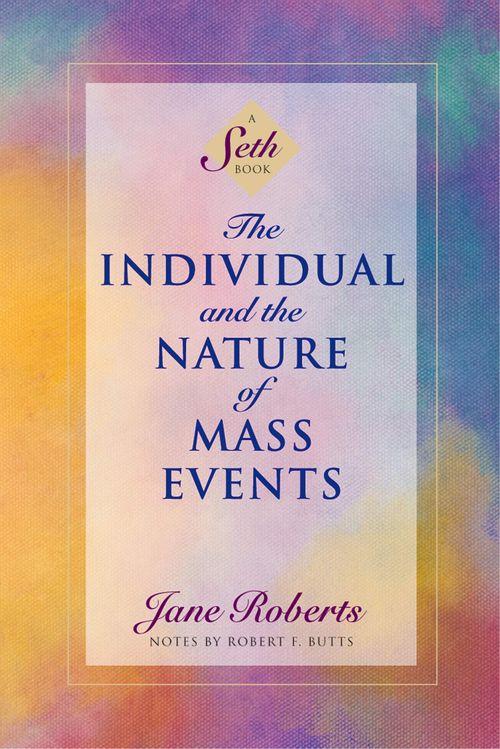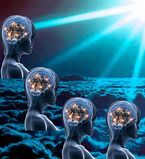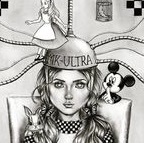JUST SETH
Mass Health & Belief Systems

First Upload: 17th November 2024,
Last Update: 1st March 2025
Contents
Introduction
Back to the best metaphysical literature available to humanity. I have read the Seth book The Individual and the Nature of Mass Events (1981, 1995), a hand full of times over the years, but after the COVID pandemic, Part 1 that covers Epidemics and Natural Disasters becomes even more relevant. This is a SethCenter summary about this book.
In this book, Seth discusses how each individual's power to create their reality merges with others “to form mass reactions such as the overthrow of governments, the birth of a new religions, wars, epidemics, earthquakes, and new periods of art, architecture, and technology.” Seth pinpoints the unconscious (and often negative) beliefs pervading science and religion, medicine and mythology. According to Seth, the basic goal of any species is quality of life, and not survival as many people believe. Individuals often choose to die together so that “their deaths amount to a mass statement.” There is a rhyme and reason behind all mass events. They are the result of belief systems held by many individuals.
Source: Seth Center link
The real question today is the mass beliefs that drove people to take an untested vaccine and why others more wisely avoided any risk. The following long extracts from mostly chapter 1 and 2 of this book are provided with highlights to permit speed reading of the most salient points. Some people will then immediately see the link with the most dangerous of all psychic epidemics, the mass psychosis. A mass psychosis is an epidemic of madness and it occurs when a large portion of a society loses touch with reality and descends into delusions, see XTwitter link.
On social media, it is now a long standing joke that the Amish did not get COVID because they don't watch TV, see XTwitter link . These extracts also cover Seth's revelations about viruses, cancer caused by parasites, gifted children and autism.
Again, in these Just Seth quotes, unnecessary punctuation, comments about delivery and interuptions that only serve to cause a distraction to the important information being delivered have been removed. Notes have been omitted because they don't provided any further specific clarity. For more background information see the introduction to the webpage Dreams, “Evolution,” And Value Fulfillment, Vol I
Seth & Jane Roberts.
Mass Health Chapter Quotes
|
|
PART ONE
THE EVENTS OF “NATURE.” EPIDEMICS AND NATURAL DISASTERS
CHAPTER 1
THE NATURAL BODY AND ITS DEFENSES
(Session 801 - 805 Extracts)
|
|
You cannot begin to understand the nature of mass events of any
kind unless-you consider the even greater framework in which they have
their existence.
A person’s private experience happens in the context of his psychological
and biological status, and basically cannot be separated from
his religious and philosophical beliefs and sentiments, and his cultural
environment and political framework —
All of the issues form together to make a trellis of behavior. Thorns
or roses may grow therein. That is, the individual will grow outward
toward the world, encountering and forming a practical experience,
traveling outward from his center in almost vinelike fashion, forming
from the fabric of physical reality a conglomeration of pleasant or
aesthetic, and unpleasant or prickly events.
The vine of experience in this analogy is formed in quite a natural
fashion from “psychic” elements that are as necessary to psychological
experience as sun, air, and water are to plants. I do not want to get too entwined in this analogy, however;
but as the individual’s personal experience must be seen in the light of all
of these issues, so mass events cannot be understood unless they are
considered in a far greater context than usual.
The question of epidemics, for example, cannot be answered from a
biological standpoint alone. It involves great sweeping
psychological attitudes on the part of many, and meets the needs and
desires of those involved — needs which, in your terms, arise in a
framework of religious, psychological and cultural realities that cannot
be isolated from biological results.
I have thus far stayed clear of many important and vital subjects,
involving mass realities, because first of all the importance of the
individual was to be stressed, and his power to form his private events.
Only when the private nature of reality was emphasized sufficiently
would I be ready to show how the magnification of individual reality
combines and enlarges to form vast mass reactions — such as, say, the
initiation of an obviously new historical and cultural period; the rise or
overthrow of governments; the birth of a new religion that sweeps all
others before it; mass conversions; mass murders in the form of wars; the
sudden sweep of deadly epidemics; the scourge of earthquakes, floods, or
other disasters; the inexplicable appearance of periods of great art or
architecture or technology.
I said there are no closed systems. This
also means that in world terms, events spin like electrons, affecting all
psychological and psychic systems as well as biological ones. It is true to
say that each individual dies alone, for no one else can die that death. It is
also true that part of the species dies with each death, and is reborn with
each birth, and that each private death takes place within the greater
context of the existence of the entire species. The death serves a purpose
species-wise while it also serves the purposes of the individual, for no
death comes unbidden.
An epidemic, for example, serves the purposes of each individual
who is involved, while it also serves its own functions in the greater
species framework.
When you consider epidemics to be the result of viruses, and
emphasize their biological stances, then it seems that the solutions are
very obvious: You learn the nature of each virus and develop an
inoculation, giving [each member of] the populace a small dose of the
disease so that a man’s own body will combat it, and he will become
immune.
The shortsightedness of such procedures is generally overlooked
because of the definite short-term advantages. As a rule, for example,
people inoculated against polio do not develop that disease. Using such
procedures, tuberculosis has been largely conquered.
There are great insidious variables operating, however, and these are
caused precisely by the small framework in which such mass epidemics
are considered.
In the first place, the causes are not biological. Biology is simply the
carrier of a “deadly intent.” In the second place, there is a difference
between a virus produced in the laboratory and that inhabiting the body
— a difference recognized by the body but not by your laboratory
instruments.
In a way the body produces antibodies, and sets
up natural immunization as a result of, say, inoculation. But the body’s
chemistry is also confused, for it “knows” it is reacting to a disease that is
not “a true disease,” but a biologically counterfeit intrusion.
To that extent — and I do not mean to overstate the case — the
body’s biological integrity is contaminated. It may at the same time
produce antibodies also, for example, to other “similar” diseases, and so
overextend its defenses that the individual later comes down with another
disease.
Now, no person becomes ill unless that illness serves a
psychic or psychological reason, so many people escape such complications.
In the meantime, however, scientists and medical men find
more and more viruses against which the population “must” be
inoculated. Each one is considered singly. There is a rush to develop a
new inoculation against the newest virus. Much of this is on a predictive
basis: The scientists “predict” how many peogple might be “attacked” by,
say, a virus that has caused a given number of deaths. Then as a
preventative measure the populace is invited to the new inoculation,
Many people who would not get the disease in any
case are then religiously inoculated with it. The body is exerted to use its
immune system to the utmost, and sometimes, according to the
inoculation, overextended [under such] conditions.4 Those individuals
who have psychologically decided upon death will die in any case, of
that disease or another, or of the side effects of the inoculation.
Inner reality and private experience give birth
to all mass events. Man cannot disentangle himself from the natural
context of his physical life. His culture, his religion, his
psychologies, and his psychological nature together form the context
within which both private and mass events occur. This book will, then, be
devoted to the nature of the great sweeping emotional, religious, or
biological events that often seem to engulf the individual, or to lift him or
her willy-nilly in their power.
What is the relationship between the individual and the gigantic mass
motions of nature, of government, or even of religion? What about mass
conversions? Mass hysteria? Mass healings, mass murder, and the
individual? Those are the questions we will devote ourselves to in this
book.
Dying is a biological necessity, not only for the individual, but to
insure the continued vitality of the species. Dying is a spiritual and
psychological necessity, for after a while the exuberant, ever-renewed
energies of the spirit can no longer be translated into flesh.
Inherently, each individual knows that he or she must die physically
in order to survive spiritually and psychically. The self
outgrows the flesh. Particularly since [the advent of Charles] Darwin’s
theories5, the acceptance of the fact of death has come to
imply a certain kind of weakness, for is it not said that only the strong
survive?
To some degree, epidemics and recognized illnesses serve the
sociological purpose of providing an acceptable reason for death — a
face-saving device for those who have already decided to die. This does
not mean that such individuals make a conscious decision to die, in your
terms: But such decisions are often semiconscious. It might be
that those individuals feel they have fulfilled their purposes — but such
decisions may also be built upon a different kind of desire for survival
than those understood in Darwinian terms.
It is not understood that before life an individual decides to live. A
self is not simply the accidental personification of the body’s biological
mechanism. Each person born desires to be born. He dies when that
desire no longer operates. No epidemic or illness or natural disaster — or
stray bullet from a murderer’s gun — will kill a person who does not
want to die.
The desire for life has been most flaunted, yet human psychology has
seldom dealt with the quite active desire for death. In its natural form this
is not a morbid, frightened, neurotic, or cowardly attempt to escape life,
but a definite, positive, “healthy” acceleration of the desire for survival,
in which the individual strongly wants to leave physical life as once the
child wanted to leave the parent’s home.
I am not speaking here of the desire for suicide, which
involves a definite killing of the body by self-deliberate means — often
of a violent nature. Ideally this desire for death, however, would simply
involve the slowing of the body’s processes, the gradual disentanglement
of psyche from flesh; or in other instances, according to individual
characteristics, a sudden, natural stopping of the body’s processes.
Left alone, the self and the body are so entwined that the separation
would be smooth. The body would automatically follow the wishes of the
inner self. In the case of suicide, for example, the self is to some extent
acting out of context with the body, which still has its own will to live.
I will have more to say about suicide, but
I do not mean here to imply guilt on the part of a person who
takes his or her own life. In many cases, a more natural death would have
ensued in any event as the result of “diseases.” Period. Often, for
example, a person wanting to die originally intended to experience only a
portion of earth life, say childhood. This purpose would be entwined with
the parents’ intent. Such a son or daughter might be born, for instance,
through a woman who wanted to experience childbirth but who did not
necessarily want to encounter the years of child-raising, for her own
reasons.
Such a mother would attract a consciousness who desired, perhaps,
to reexperience childhood but not adulthood, or who might teach the
mother lessons sorely needed. Such a child might naturally die at 10 or
12, or earlier. Yet the ministrations of science might keep the child alive
far longer, until such a person [begins] encountering an adulthood thrust
upon him or her, so to speak.
An automobile accident, suicide, or another kind of accident might
result. The person might fall prey to an epidemic, but the smoothness of
biological motion or psychological motion has been lost. I am not here
condoning suicide, for too often in your society it is the unfortunate result
of conflicting beliefs — and yet it is true to say that all deaths are suicide,
and all births deliberate on the part of child and parent. To that extent,
you cannot separate issues like a population explosion on the part of
certain portions of the world, from epidemics, earthquakes, and other
disasters.
In wars, people automatically reproduce their kind to
make up for those that are killed, and when the race overproduces there
will be automatic controls set upon the population. Yet these will in all
ways fit the intents and purposes of the individuals involved.
Now: To a certain extent,
epidemics are the result of a mass suicide phenomenon on the parts of those
involved. Biological, sociological, or even economic factors may be involved, in
that for a variety of reasons, and at different levels, whole groups of individuals
want to die at any given time — but in such a way that their individual deaths
amount to a mass statement.
On one level the deaths are a protest against the time in which they occur.
Those involved have private reasons, however. The reasons, of course, vary
from one individual to another, yet all involved “want their death to serve a
purpose” beyond private concerns. Partially, then, such deaths are meant to
make the survivors question the conditions — for unconsciously the
species well knows there are reasons for such mass deaths that go beyond
accepted beliefs.
In some historical periods the plight of the poor was so horrible, so
unendurable, that outbreaks of the plague occurred, literally resulting in a
complete destruction of large areas of the environment in which such social,
political, and economic conditions existed. [Those] plagues took rich and poor
alike, however, so the complacent well-to-do could see quite clearly, for
example, that to some extent sanitary conditions, privacy, peace of mind, had to be
granted to the poor alike, for the results of their dissatisfaction would
have quite practical results. Those were deaths of protest.1
Individually, each “victim” was to one extent or another a “victim” of
apathy, despair, or hopelessness, which automatically lowered bodily
defenses.
Not only do such states of mind lower the defenses, however, but
they activate and change the body’s chemistries, alter its balances, and
initiate disease conditions. Many viruses inherently capable of causing
death, in normal conditions contribute to the overall health of the body,
existing side by side as it were with other viruses, each contributing quite
necessary activities that maintain bodily equilibrium.
If [certain viruses] are triggered, however, to higher activity or
overproduction by mental states, they then become “deadly.” Physically
they may be passed on in whatever manner is peculiar to a specific strain.
Literally, individual mental problems of sufficient severity emerge as
social, mass diseases.
The environment in which an outbreak occurs points
at the political, sociological, and economic conditions that have evolved,
causing such disorder. Often such outbreaks take place after ineffective
political or social action — that is, after some unified mass social protest
— has failed, or is considered hopeless. They often occur also in wartime
on the part of a populace [that] is against a given war in which [its]
country is involved.
Initially there is a psychic contagion: Despair moves faster than a
mosquito, or any outward carrier of a given disease. The mental state
brings about the activation of a virus that is, in those terms, passive.
Despair may seem passive only because it feels
that exterior action is hopeless — but its fires rage inwardly, and that
kind of contagion can leap from bed to bed and from heart to heart. It
touches those, however, who are in the same state only, and to some
extent it brings about an acceleration in which something can indeed be
done in terms of group action.
Now if you believe in one life only, then such conditions will seem
most disastrous, and in your terms they clearly are not pretty. Yet, though
each victim in an epidemic may die his or her own death, that death
becomes part of a mass social protest. The lives of intimate survivors are
shaken, and according to the extent of the epidemic
the various elements of social life itself are disturbed, altered, rearranged.
Sometimes such epidemics are eventually responsible for the overthrow
of governments, the loss of wars.
There are also even deeper biological connections with the heart of
nature. You are biological creatures. Your proud human consciousness
rests on the vast “unconscious” integrity of your physical being. In that
regard your consciousness is as natural as your toe. In terms of the
species’ integrity your mental states are, then, highly important. Despair
or apathy is a biological “enemy.” Social conditions, political states,
economic policies, and even religious or philosophical frameworks that
foster such mental states, bring about a biological retaliation. They act
like fire applied to a plant.
The epidemics then serve many purposes — warning that certain
conditions will not be tolerated. There is a biological outrage that will be
continually expressed until the conditions are changed.
Even in the days of the
great plagues in England there were those smitten who did not die, and
there were those untouched by the disease who dealt with the sick and
dying. Those survivors, who were actively involved, saw themselves in a
completely different light than those who succumbed, however: They
were those, untouched by despair, who saw themselves as effective rather
than ineffective. Often they roused themselves from lives of previously
unheroic situations, and then performed with great bravery. The horror of
the conditions overwhelmed them where earlier they were not involved.
The sight of the dying gave them visions of the meaning of life, and
stirred new [ideas] of sociological, political, and spiritual natures, so that
in your terms the dead did not die in vain. Epidemics by their public
nature speak of public problems — problems that sociologically threaten
to sweep the individual to psychic disaster as the physical materialization
does biologically.
These are the reasons also for the range or the limits of
various epidemics — why they sweep through one area and leave another
clear. Why one in the family will die and another survive — for in this
mass venture, the individual still forms his or her private reality.
In your society scientific
medical beliefs operate, and a kind of preventative medicine,
mentioned earlier, in which procedures [of inoculation] are taken,
bringing about in healthy individuals a minute disease condition that then
gives immunity against a more massive visitation. In the case of any
given disease this procedure might work quite well for those who believe
in it. It is, however, the belief, and not the procedure, that works.2
I am not recommending that you abandon the procedure when it
obviously works for so many — yet you should understand why it brings
about the desired results.
Such medical technology is highly specific, however. You cannot be
inoculated with the desire to live, or with the zest, delight, or contentment
of the healthy animal. If you have decided to die, protected
from one disease in such a manner, you will promptly come down with
another, or have an accident. The immunization, while specifically
effective, may only reinforce prior beliefs about the body’s
ineffectiveness. It may appear that left alone the body would surely
develop whatever disease might be “fashionable” at the time, so that the
specific victory might result in the ultimate defeat as far as your beliefs
are concerned.
You have your own medical systems, however. I do not mean to
undermine them, since they are undermining themselves. Some of my
statements clearly cannot be proven, in your terms, and appear almost
sacrilegious. Yet, throughout your history no man or woman has died
who did not want to die, regardless of the state of medical technology.
Specific diseases have certain symbolic meanings, varying with the times
and the places.3
There has been great discussion in past years about the
survival of the fittest, in Darwinian terms,4 but little emphasis is placed
upon the quality of life, or of survival itself; or in human terms, [there
has been] little probing into the question of what makes life worthwhile.
Quite simply, if life is not worthwhile, no species will have a
reason to continue.
Civilizations are literally social species. They die when they see no
reason to live, yet they seed other civilizations. Your private mental
states en masse bring about the mass cultural stance of your civilization.
To some extent, then, the survival of your civilization is
quite literally dependent upon the condition of each individual; and that
condition is initially a spiritual, psychic state that gives birth to the
physical organism. That organism is intimately connected to the natural
biological state of each other person, and to each other living thing, or
entity, however minute.
Despite all “realistic” pragmatic tales to the contrary,
the natural state of life itself is one of joy, acquiescence with itself — a
state in which action is effective, and the power to act is a natural right.
You would see this quite clearly with plants, animals, and all other life if
you were not so blinded by beliefs to the contrary. You would feel it in
the activity of your bodies, in which the vital individual affirmation of
your cells brings about the mass, immensely complicated achievement of
your physical being. That activity naturally promotes health and vitality.
I am not speaking of some romanticized, “passive,” floppy, spiritual
world, but of a clear reality without impediments, in which the opposite
of despair and apathy reigns.
This book will be devoted, then, to those conditions that best promote
spiritual, psychic, and physical zest, the biological and psychic
components that make a species desire to continue its kind. Such aspects
promote the cooperation of all kinds of life on all levels with one another.
No species competes with another, but cooperates to form an
environment in which all kinds can creatively exist.
You live in a physical community, but you live first of all in a community
of thoughts and feelings. These trigger your physical actions.
They directly affect the behavior of your body. The experience of the
animals is different, yet in their own ways animals have both individual
intent and purpose. Their feelings are certainly as pertinent as yours.
They dream, and in their way they reason.
They do not “worry.” They do not anticipate disaster when no signs
of it are apparent in their immediate environment. On their own they do
not need preventative medicine. Pet animals are inoculated against
diseases, however. In your society this almost becomes a necessity. In a
“purely natural” setting you would not have as many living puppies or
kittens. There are stages of physical existence, and in those terms nature
knows what it is doing. When a species overproduces, the incidences of,
say, epidemics grow. This applies to human populations as well as to the
animals.
The quality of life is important above all. Newborn animals either die
quickly and naturally, painlessly, before their consciousnesses are fully
focused here, or are killed by their mothers — not because they are weak
or unfit to survive, but because the [physical] conditions are not those
that will produce the quality of life that makes survival “worthwhile.”
The consciousness that became so briefly physical is not annihilated,
however, but in your terms waits for better conditions.
There are also “trial runs” in human and animal species alike, in
which peeks are taken, or glimpses, of physical life, and that is all.
Epidemics sweeping through animal populations are also biological and
psychic statements, then, in which each individual knows that only its
own greatest fulfillment can satisfy the quality of life on an individual
basis, and thus contribute to the mass survival of the species.
Suffering is not necessarily good for the soul at all,
and left alone natural creatures do not seek it. There is a natural
compassion, a biological knowledge, so that the mother of an animal
knows whether or not existing conditions will support the new offspring.
Animals instinctively realize their relationship with the great forces of
life. They will instinctively starve an offspring while its consciousness is
still unfocused, rather than send it loose under adverse conditions.
In a natural state, many children would die stillborn for the same
reasons, or would be naturally aborted. There is a give-and-take between
all elements of nature, so that such individuals often choose mothers, for
example, who perhaps wanted the experience of pregnancy but not of
birth — where they choose the experience of the fetus but not necessarily
[that] of the child. Often in such cases these
are “fragment personalities,” wanting to taste physical reality, but not being
ready to deal with it. Each case is individual, however, so these are general
statements.
Many children, who, it seems, should have died of disease, of “childhood
epidemics,” nevertheless survive because of their different intents. The world of
thought and feeling may be invisible, and yet it activates all physical systems
with which you are acquainted.
Animals as well as men can indeed make social statements, that appear in a
biological context. Animals stricken by kitten and puppy diseases, for example,
choose to die, pointing out the fact that the quality of their lives individually and en masse is vastly lacking. Their relationships with their own species is no longer in balance. They cannot use their full abilities or powers, nor are many of them given compensating elements in terms of a beneficial psychic relationship with man — but instead are shunted aside, unwanted and unloved. An unloved animal does not want to live.
Love involves self-respect, the trust in individual biological zest and
integrity. To that extent, in their way animal epidemics have the same causes as human ones.
An animal can indeed commit suicide. So can a race or a species. The
dignity of a spirited life demands that a certain quality of experience be
maintained.
Your scientists are beginning to understand man’s physical
relationship with nature. The species is obviously a part of nature and not
apart from it.
Environmental questions are being raised about man’s effects upon
the world in which he lives. There is, however, an inner environment that
connects all consciousnesses that dwell upon your planet, in whatever
form. This mental or psychic — or in any case nonphysical —
environment is ever in a state of flux and motion. That activity provides
you with all exterior phenomena.
Your sense perception, physically speaking, is
a result of behavior on the part of organs that seem to you to have no
reality outside of their relationship with you. Those organs are
themselves composed of atoms and molecules with their own consciousnesses.
They have, then, their own states of sensation and cognition.
They work for you, allowing you to perceive physical reality.
Your ears certainly seem to be permanent appendages, and so do
your eyes. You say: “My eyes are blue,” or “My ears are small.” The
physical matter of those sense organs changes constantly, however, with
you none the wiser. While your body appears quite dependable, solid,
[and] steady, you are not aware of the constant interchanges that occur
between it and the physical environment. It does not bother you one whit
that the physical substance of your body is made up of completely
different atoms and molecules than it was composed of seven years ago,
[say], or that your familiar hands are actually innocent of any smallest
smidgen of matter that composed them [even in recent times past].
You perceive your body as solid. Again, the very senses that make
such a deduction are the result of the behavior of atoms and molecules
literally coming together to form the organs, filling a pattern of flesh. All
other objects that you perceive are formed in their own way in the same
fashion.
The physical world that you recognize is made up of invisible
patterns. These patterns are “plastic,” in that while they exist, their final
form is a matter of probabilities directed by consciousness. Your senses
perceive these patterns in their own ways. The patterns themselves can be
“activated” in innumerable fashions. There is something out there
to observe.
Your sense apparatus determines
what form that something will take, however. The mass world rises
up before your eyes, but your eyes are part of that mass world. You
cannot see your thoughts, so you do not realize that they have shape and
form, even as, say, clouds do. There are currents of thought as there are
currents of air, and the mental patterns of men’s feelings and thoughts rise
up like flames from a fire, or steam from hot water, to fall like ashes or
like rain.
All elements of the interior invisible environment work together, and
they form the temporal weather patterns that are exteriorized mental
states, presenting you locally and en masse, then, with a physical version
of man’s emotional states. Period.
Now: The physical planet is obviously also ever-changing while it is
operationally or realistically or pragmatically relatively stable. The
physical matter of the planet is also composed of literally infinite hordes
of consciousnesses — each experiencing its own reality while adding to
the overall cooperative venture.
Natural disasters represent an understandably prejudiced
concept, in which the vast creative and rejuvenating elements
important to planetary life, and therefore to mankind, are ignored. The
stability of the planet rests upon such changes and alterations, even as the
body’s stability is dependent upon, say, the birth and death of the cells.
It is quite obvious that people must die — not only because
otherwise you would overpopulate your world into extinction,
but because the nature of consciousness requires new experience,
challenge, and accomplishment. This is everywhere apparent in nature
itself. If there were no death, you would have to invent it (smile)
— for the context of that selfhood would be as limited as the experience
of a great sculptor given but one hunk of stone 1.
The sculptor’s creation is pragmatically realistic, in that it exists as an
object, and can be quite legitimately perceived, as can your world. The
sculptor’s statue, however, comes from the inner environment, the
patterns of probabilities. These patterns are not themselves inactive. They
are possessed by the desire to be-actualized (with a hyphen). Behind all
realities there are mental states. These always seek form, though again
there are other forms than those you recognize. [...]
Each person’s thoughts flow into that formation, forming part of the
earth’s psychic atmosphere. From that atmosphere flows the natural
earthly patterns from which your seasons emerge with all of their variety
and effects. You are never victims of natural disasters, though it may
seem that you are, for you have your hand in forming them. You are
creatively involved in the earth’s cycles. No one can be born for you, or
die for you, and yet no birth or death is really an isolated event, but one in
which the entire planet participates. In personal terms, again, each species
is concerned not only with survival but with the quality of its life and
experience.
In those terms, natural disasters ultimately end up righting a
condition that earlier blighted the desired quality of life, so that
adjustments were made.
The “victims” choose to participate in those conditions at spiritual,
psychological, and biological levels. Many of those who are counted
among the fatalities might otherwise die of extended illnesses, for
example. At cellular levels such knowledge is available, and in one way
or another imparted, often in dreams, to the individual. Conscious
comprehension need not follow, for many people know such things, and
pretend not to know them at the same time.
Others have finished with their challenges; they want to die
and are looking for an excuse — a face-saving device. However, those
who choose such deaths want to die in terms of drama, in the middle of
their activities, and are in a strange way filled with the exultant inner
knowledge of life’s strength even at the point of death. At the last they
identify with the power of nature that seemingly destroyed them.
That identification often brings about in death — but not always —
an added acceleration of consciousness, and involves such individuals in
a kind of “group death experience,” where all of the victims more or less
embark into another level of reality “at the same time.”
Those people were aware just beneath consciousness of the possibilities
of such an event long before the disaster occurred, and could
until the last moment choose to avoid the encounter. Animals know of
weather conditions ahead of time, as old tales say. This perception is a
biological part of your heritage also. The body is prepared, though
consciously it seems you are ignorant.
There are innumerable relationships that exist between the interior
environment of the body and the weather patterns. The ancient feelings of
identification with storms are quite valid, and in that respect the “realism”
of feelings is far superior to the realism of logic. When a person feels a
part of a storm, those feelings speak a literal truth. Logic deals with
exterior conditions, with cause-and-effect relationships. Intuitions deal
with immediate experience of the most intimate nature, with subjective
motions and activities that in your
terms move far quicker than the speed of light, and with simultaneous events
that your cause-and-effect level is far too slow to perceive.2
In that regard also, the activities of the inner environment are
too fast for you to follow intellectually. Your intuitions, however, can give you
clues to such behavior. A country is responsible for its own droughts,
earthquakes, floods, hurricanes — and for its own harvests and rich display of
products, its industry and cultural achievements, and each of these elements is
related to each other one.
If the quality of life that is considered spiritually and biologically necessary
fails, then adjustments occur. A political problem might be altered by a natural
disaster if political means fail. On the other hand, the rousing creative energies
of the people will emerge.
Excellence will show itself through the arts, cultural creativity,
technological or sociological accomplishments. The species tries to fulfill its
great capacities. Each physical body in its own way is like the world. It has its
own defenses and abilities, and each portion of it strives for a quality of
existence that will bring to the smallest parts of it the spiritual and biological
fulfillment of its own nature.
The body is a spiritual, psychic, and social
statement, biologically spoken. It is obviously private, yet it cannot be
concealed, in that “it is where you are,” in usual terms.[...]
At cellular levels the world exists with a kind of social interchange,
in which the birth and death of cells are known to all others, and in which
the death of a frog and a star gain equal weight. But at your level of
activity your thoughts, feelings, and intents, however private, form part
of the inner environment of communication. This inner environment is as
pertinent and vital to the species’ well-being as is the physical one. It
represents the psychic, mass bank of potential, even as the planet
provides a physical bank of potential. When there is an earthquake in
another area of the world, the land mass in your own country is in one
way or another affected. When there are psychic earthquakes in other
areas of the world, then you are also affected, and usually to the same
degree.
In the same way, if one portion of your own body is injured, then
other portions feel the effects of the wound. An earthquake can be a
disaster in the area where it occurs, even though its existence corrects
imbalances, and therefore promotes the life of the planet. Emergency
actions are quite rigorous in the immediate area of an earthquake, and aid
is sent in from other countries. When an area of the body “erupts,” there
are also emergency measures taken locally, and aid sent from other
portions of the body to afflicted parts.
The physical eruption, while it may appear to be a disaster in the area
of the disease, is also, however, a part of the body’s defense system,
taken to insure the whole balance of the body. Biologically, illness
therefore represents the overall body defense system at work.
I am trying to put this simply — but without some illnesses,
the body could not endure. First of all, the body
must be in a state of constant change, making decisions far too fast for
you to follow, adjusting hormonal levels, maintaining balances between
all of its systems; not only in relationship to itself — the body — but to
an environment that is also in constant change. At biological levels the
body often produces its own “preventative medicine,” or “inoculations,”
by seeking out, for example, new or foreign substances in its environment
[that are] due to nature, science or technology; it assimilates such
properties in small doses, coming down with an “illness” which, left
alone, would soon vanish as the body utilized what it could [of it], or
socialized “a seeming invader.”
The person might feel indisposed, but in such ways the body
assimilates and uses properties that would otherwise be called alien ones.
It immunizes itself through such methods. The body, however, exists
with the mind to contend with — and the mind produces an inner
environment of concepts. The cells that compose the body do not try to
make sense of the cultural world. They rely upon your interpretation,
therefore, for the existence of threats of a non-biological nature. So they
depend upon your assessment.
If that assessment correlates with biological ones, you
have a good working relationship with the body. It can react swiftly and
clearly. When you sense threat or danger for which the body can find no
biological correlation, even as through cellular communication it scans
the environment physically, then it must rely upon your assessment and
react to danger conditions. The body will, therefore, react to imagined
dangers to some degree, as well as to those that are biologically pertinent.
Its defense system often becomes overexerted as a result.
The body is, therefore, quite well equipped to deal with its physical
stance in the physical world, and its defense systems are unerring in that
respect. Your conscious mind, however, directs your temporal perception
and interprets that perception, organizing it into mental patterns. The
body, again, must depend upon those interpretations. The biological basis
of all life is a loving, divine and cooperative one, and presupposes a safe
physical stance from which any member of any species feels actively free
to seek out its needs and to communicate with others of its kind.
It is fashionable to believe that
the animals do not possess imagination, but this is a quite erroneous
belief. They anticipate mating, for example, before its time. They all
learn through experience, and despite all of your concepts, learning is
impossible without imagination at any level.
In your terms, the imagination of the animals is limited. Theirs is not
merely confined to the elements of previous experience, however. They
can imagine events that have never happened to them. Man’s abilities in
this respect are far more complicated, for in his imagination he deals with
probabilities. In any given period of time, with one physical body, he can
anticipate or perform an infinitely vaster number of events — each one remaining probable until he activates it.
The body, responding to his thoughts, feelings, and beliefs, has much
more data to deal with, therefore, and must have a clear area in which
concise action is possible.
The body’s defense system is automatic, and yet .to a certain degree
it is a secondary rather than primary system, coming into mobilization as
such only when the body is threatened.
The body’s main purpose is not only to survive but to maintain a
quality of existence at certain levels, and that quality itself promotes
health and fulfillment. A definite, biologically pertinent fear alerts the
body, and allows it to react completely and naturally. You might be
reading a newspaper headline, for example, as you cross a busy street.
Long before you are consciously aware of the circumstances, your body
might leap out of the path of an approaching car. The body is doing what
it is supposed to do. Though consciously you were not afraid, there was a
biologically pertinent fear that was acted upon.
If, however, you dwell mentally in a generalized environment of fear,
the body is given no clear line of action, allowed no appropriate response.
Look at it this way: An animal, not necessarily just a wild one in some
native forest, but an ordinary dog or cat, reacts in a certain fashion. It is
alert to everything in its environment. A cat does not anticipate danger
from a penned dog four blocks away, however, nor bother wondering
what would happen if that dog were to escape and find the cat’s cozy
yard.
Many people, however, do not pay attention to everything in their
environments, but through their beliefs concentrate only upon “the
ferocious dog four blocks away.” That is, they do not respond to what is
physically present or perceivable in either space or time, but instead
[dwell] upon the threats that may or may not exist, ignoring at the same
time other pertinent data that are immediately at hand.
The mind then signals threat — but a threat that is nowhere
physically present, so that the body cannot clearly respond. It therefore
reacts to a pseudothreatening situation, and is caught between
gears, so to speak, with resulting biological confusion. The body’s
responses must be specific.
The overall sense of health, vitality, and resiliency is a generalized
condition of contentment — brought about, however, by multitudinous
specific responses. Left alone, the body can defend itself against any
disease, but it cannot defend itself appropriately against an exaggerated
general fear of disease on the individual’s part. It must mirror your own
feelings and assessments. Usually, now, your entire medical systems
literally generate as much disease as is cured
— for you are everywhere hounded by the symptoms of various dis
eases, and filled with the fear of disease, overwhelmed by what seems
to be the body’s propensity toward illness — and nowhere is the
body’s vitality or natural defense system stressed.
Private disease, then, happens also in a social context. This context is
the result of personal and mass beliefs that are intertwined at all cultural
levels, and so to that extent serve private and public purposes.
The illnesses generally attributed to all different
ages are involved. Those of the elderly, again, fit in with your social and
cultural beliefs, the structure of your family life. Old animals have their
own dignity, and so should old men and women. Senility is a mental and
physical epidemic — a needless one. You “catch” it because when you
are young you believe that old people cannot perform. There are no
inoculations against beliefs, so when young people with such beliefs
grow old they become “victims.”2
The kinds of diseases change through historical periods. Some
become fashionable, others go out of style. All epidemics, however, are
mass statements both biologically and psychically. They point to mass
beliefs that have brought about certain physical conditions that are
abhorrent at all levels. They often go hand-in-hand with war, and
represent biological protests.
Whenever the conditions of life are such that its
quality is threatened, there will be such a mass statement. The quality of
life must be at a certain level so that the individuals of a species
— of any and all species — can develop. In your species the spiritual,
mental and psychic abilities add a dimension that is biologically
pertinent.
There simply must be, for example, a freedom to express ideas, an
individual tendency, a worldwide social and political context in which
each individual can develop his or her abilities and contribute to the
species as a whole. Such a climate depends, however, upon many ideas
not universally accepted — and yet the species is so formed that the
biological importance of ideas cannot be stressed too strongly.
More and more, the quality of your lives is formed through the
subjective realities of your feelings and mental constructions. Again,
beliefs that foster despair are biologically destructive. They cause the
physical system to shut down. If mass action against appalling social or
political conditions is not effective, then other means are taken, and these
are often in the guise of epidemics or natural disasters. The blight is
wiped out in one way or another.
Such conditions, however, are the results of beliefs, which are
mental, and so the most vital work must always be done in that area.
An animal has a sense of its own biological integrity. So does a
child. In all forms of life each individual is born into a
world already provided for it, with circumstances favorable to its growth
and development; a world in which its own existence rests upon the
equally valid existence of all other individuals and species, so that each
contributes to nature’s whole. [...]
During their lifetimes animals in their natural state enjoy their vigor
and accept their worth. They regulate their own births — and their own
deaths. The quality of their lives is such that their abilities are challenged.
They enjoy contrasts: that between rest and motion, heat and cold, being
in direct contact with natural phenomena that
everywhere quickens their experience. They will migrate if necessary to
seek conditions more auspicious. They are aware of approaching natural
disasters, and when possible will leave such areas. They will protect their
own, and according to circumstances and conditions they will tend their
own wounded. Even in contests between young and old males for control
of a group, under natural conditions the loser is seldom killed. Dangers
are pinpointed clearly so that bodily reactions are concise.
The animal knows he has the right to exist, and a place in the fabric
of nature. This sense of biological integrity supports him.
Man, on the other hand, has more to contend with. He must deal with
beliefs and feelings often so ambiguous that no clear line of action seems
possible. The body often does not know how to react. If you believe that
the body is sinful, for example, you cannot expect to be happy, and
health will most likely elude you,, for your dark beliefs will blemish the
psychological and biological integrity with which you were born.
The species is in a state of transition, one of many. This one began,
generally speaking, when the species tried to step apart from nature in
order to develop the unique kind of consciousness that is presently your
own. That consciousness is not a finished product, however, but one
meant to change, [to] evolve and develop. Certain artificial divisions
were made along the way that must now be dispensed with.
You must return, wiser creatures, to the nature that spawned
you — not only as loving caretakers but as partners with the other species
of the earth. You must discover once again the spirituality of your
biological heritage. The majority of accepted beliefs — religious,
scientific, and cultural — have tended to stress a sense of powerlessness,
impotence, and impending doom — a picture in which man and his world
is an accidental production with little meaning, isolated yet seemingly
ruled by a capricious God. Life is seen as “a valley of tears” — almost as
a low-grade infection from which the soul can be cured only by death.
Religious, scientific, medical, and cultural communications stress the
existence of danger, minimize the purpose of the species or of any
individual member of it, or see mankind as the one erratic, half-insane
member of an otherwise orderly realm of nature. Any or
all of the above beliefs are held by various systems of thought. All of
these, however, strain the individual’s biological sense of integrity,
reinforce ideas of danger, and shrink the area of psychological safety that
is necessary to maintain the quality possible in life. The body’s defense
systems become confused to varying degrees.
I do not intend to give a treatise upon the biological structures of the
body and their interworkings, but only to add such information in that
line that is not currently known, and is otherwise important to the ideas I
have in mind. I am far more concerned [with] more basic issues. The
body’s defenses will take care of themselves if they are allowed to, and if
the psychological air is cleared of the true “carriers” of disease.
|
|
CHAPTER 2
“MASS MEDITATIONS.” “HEALTH” PLANS FOR DISEASE.
EPIDEMICS OF BELIEFS, AND EFFECTIVE MENTAL
“INOCULATIONS” AGAINST DESPAIR
(Session 805 - 815 Extracts)
|
|
While in this book I will point out some of
the unfortunate areas of private and mass experience, I will also provide
some suggestions for effective solutions. “You get what you concentrate
upon.”1 Your mental images bring about their own fulfillment. These are
ancient dictums, but you must understand the ways in which your mass
communication systems amplify both the “positive and the negative“
issues.
I may for a while stress the ways in which individually, and as a
civilization, you have undermined your own feelings of safety; yet I will
also give you methods to reinforce those necessary feelings of biological
integrity and spiritual comprehension that can vastly increase your
spiritual and physical existence.
Your beliefs have generated feelings of unworth. Having artificially
separated yourselves from nature, you do not trust it, but often experience
it as an adversary. Your religions granted man a soul, while denying any
to other species. Your bodies then were relegated to nature and your souls
to God, who stood immaculately apart from His creations.
Your scientific beliefs tell you that your entire world happened
accidentally. Your religions tell you that man is sinful: The body is not to
be trusted; the senses can lead you astray. In this maze of beliefs you
have largely lost a sense of your own worth and purpose. A generalized
fear and suspicion is generated, and life too often becomes stripped of
any heroic qualities. The body cannot react to generalized threats. It is,
therefore, put under constant strain in such circumstances, and seeks to
specify the danger. It is geared to act in your protection. It builds up
strong stresses, therefore, so that on many occasions a specific disease or
threat situation is “manufactured” to rid the body of a tension grown too
strong to bear.
Many of my readers are familiar with private meditation, when
concentration is focused in one particular area. There are many methods
and schools of thought here, but a highly suggestive state of mind results,
in which spiritual, mental, and physical goals are sought. It is impossible
to meditate without a goal, for that intent is itself a purpose.
Unfortunately, many of your public health programs, and commercial
statements through the various media, provide you with mass meditations
of a most deplorable kind. I refer to those in which the specific symptoms
of various diseases are given, in which the individual is further told to
examine the body with those symptoms in mind. I also refer to those
statements that just as unfortunately specify diseases for which the
individual may experience no symptoms of an observable kind, but is
cautioned that these disastrous physical events may be happening despite
his or her feelings of good health. Here the generalized fears fostered by
religious, scientific, and cultural beliefs are often given as blueprints of
diseases in which a person can find a specific focus — the individual can
say: “Of course, I feel listless, or panicky, or unsafe since I have suchand-
such a disease.”
The breast cancer suggestions associated with self-examinations have
caused more cancers than any treatments have cured.
They involve intense meditation of the body, and adverse imagery that
itself affects the bodily cells.2 Public health announcements about high
blood pressure themselves raise the blood pressure of millions of
television viewers.
Your current ideas of preventative medicine, therefore, generate the
very kind of fear that causes disease. They all undermine the
individual’s sense of bodily security and increase stress, while offering
the body a specific, detailed disease plan. But most of all, they operate to
increase the individual sense of alienation from the body, and to promote
a sense of powerlessness and duality.
Your “medical commercials” are equally disease-promoting. Many,
meaning to offer you relief through a product, instead actually promote
the condition through suggestion, thereby generating a need for the
product itself.
Headache remedies are a case in point here. Nowhere do any
medically-oriented commercial or public service announcements mention
the body’s natural defenses, its integrity, vitality, or strength. Nowhere in
your television or radio matter is any emphasis put upon the healthy.
Medical statistics deal with the diseased. Studies upon the healthy are not
carried out.
More and more foods, drugs, and natural environmental conditions
are being added to the list of disease-causing elements. Different reports
place dairy products, red meats, coffee, tea, eggs, and fats on the list.
Period. Generations before you managed to subsist on many such foods,
and they were in fact promoted as additive to health. Indeed, man almost
seems to be allergic to his own natural environment, a prey to the weather
itself.
It is true that your food contains chemicals it did not in years past.
Yet within reason man is biologically capable of assimilating such
materials, and using them to his advantage.
When man feels powerless, however, and in a state of generalized
fear; he can even turn the most natural earthly ingredients against
himself. Your television, and your arts and sciences as well, add up to
mass meditations. In your culture, at least, the educated in the literary arts
provide you with novels featuring antiheroes, and often portray an
individual existence [as being] without meaning, in which no action is
sufficient to mitigate the private puzzlement or anguish.
Many — not all — plotless novels or movies are the result of this
belief in man’s powerlessness. In that context no action is heroic, and
man is everywhere the victim of an alien universe. On the other hand
your common, unlettered, violent television dramas do indeed provide a
service lor ilicy imaginatively specify a generalized fear in
a given situation, which is then resolved through drama. Individual action
counts. The plots may be stereotyped or the acting horrendous, but in the
most conventional terms the “good” man wins.
Such programs do indeed pick up the generalized fears of
the nation, but they also represent folk dramas — disdained by the
intelligentsia — in which the common man can portray heroic
capabilities, act concisely toward a desired end, and triumph.
Those programs often portray your cultural world in exaggerated
terms, and most resolution is indeed through violence. Yet your more
educated beliefs lead you to an even more pessimistic picture, in which
even the violent action of men and women who are driven to the extreme
serves no purpose. The individual must feel that his actions count. He is
driven to violent action only as a last resort — and illness often is that
last resort.
Your television dramas, the cops-and-robbers shows,
the spy productions, are simplistic, yet they relieve tension in away that
your public health announcements cannot do. The viewer can say: “Of
course I feel panicky, unsafe, and frightened, because I live in such a
violent world.” The generalized fear can find a reason [for its existence].
But the programs at least provide a resolution dramatically set, while the
public health announcements continue to generate unease. Those mass
meditations therefore reinforce negative conditions.
In the overall, then, violent shows provide a service, in that they
usually promote the sense of a man’s or a woman’s individual power over
a given set of circumstances. At best the public service announcements
introduce the doctor as mediator: You are supposed to take your body to
a doctor as you take your car to a garage, to have its parts serviced. Your
body is seen as a vehicle out of control, that needs constant scrutiny.
The doctor is like a biological mechanic, who knows your body far
better than you. Now these medical beliefs are intertwined with your
economic and cultural structures, so you cannot lay the blame upon
medical men or their profession alone. Your economic well-being is also
a part of your personal reality. Many dedicated doctors use medical
technology with spiritual understanding, and they are themselves the
victims of the beliefs they hold.
If you do not buy headache potions, your uncle or your neighbor may be out
of business and not able to support his family, and therefore lack the means to
buy your wares. You cannot disconnect one area of life from another. En masse,
your private beliefs form your cultural reality. Your society is not a thing in
itself apart from you, but the result of the individual beliefs of each person in it.
There is no stratum of society that you do not in one way or another affect. Your
religions stress sin. Your medical profession stresses disease. Your orderly
sciences stress the chaotic and accidental theories of creation. Your psychologies
stress men as victims of their backgrounds. Your most advanced thinkers
emphasize man’s rape of the planet, or focus upon the future disaster that will
overtake the world, or see men once again as victims of the stars.
Many of your resurrected occult schools speak of a recommended death of
desire, the annihilation of the ego, for the transmutation of physical elements to
finer levels. In all such cases the clear spiritual and biological integrity of the
individual suffers, and the precious immediacy of your moments is largely lost.
Earth life is seen as murky, a dim translation of greater existence, rather
than portrayed as the unique, creative, living experience that it should be. The
body becomes disoriented, sabotaged. The clear lines of communication between
spirit and body become cluttered. Individually and en masse, diseases and
conditions result that are meant to lead you into other realizations.
[...]
While Ruburt was working at one of his books a few
days ago, he heard a public service announcement. The official told all listeners
that the flu season had officially begun. He sternly suggested that the elderly and
those with certain diseases make appointments at once for flu shots.
The official mentioned, by the way, that there was indeed no direct evidence
connecting past flu shots with the occurrence of a rather bizarre disease that
some of those inoculated with the flu vaccine happened to come down with.4 All
in all, it was quite an interesting announcement, with implications that straddle
biology, religion, and economics. “The flu season” is in a way an example of a psychologically-manufactured pattern that can at times bring about a manufactured epidemic.
Behind such announcements there is the authority of the medical profession,
and the very authority of your systems of communication as well. You cannot
question the voice over the radio. It is disembodied and presumes to know.
Once again, the elderly were singled out. It seems obvious that they are
more susceptible to diseases. That susceptibility is a medical fact of life. It is a
fact, however, without a basic foundation in the truth of man’s biological reality. It is a fact brought about through suggestion. The doctors see the bodily results, which are quite definite, and then those results are taken as evidence.
In a few isolated areas of the world even today, the old are not diseaseridden,
nor do their vital signs weaken. They remain quite healthy until the time
of death.
Their belief systems, therefore, you must admit, are quite practical. Nor are
they surrounded by medical professions. Later in the book we will return to the
subject. Here, you have, however, what
almost amounts to a social program for illness — the flu season. A mass
meditation, it has an economic structure in back of it: The scientific and
medical foundations are involved. Not only this, however, but the
economic concerns, from the largest pharmacies to the tiniest drugstores,
the supermarkets and the corner groceries — all of these elements are
involved.
Pills, potions, and shots supposed to combat [colds and the] flu are
given prominent displays, serving to remind those who might have
missed them otherwise of the announcements [about] the coming time of
difficulty. Commercials on television bring a new barrage, so that
you can go from the hay fever season to the flu season without
missing any personal medications.
A cough in June may be laughed off and quickly forgotten. A cough
in the flu season, however, is far more suspect — and under such
conditions one might think, particularly in the midst of a poor week:
“Who wants to go out tomorrow anyhow?”
You are literally expected to come down with the flu. It can serve as
an excuse for not facing many kinds of problems. Many people are
almost consciously aware of what they are doing. All they have to do is
pay attention to the suggestions offered so freely by the society. The
temperature does rise. Concern causes the throat to become dry. Dormant
viruses — which up to now have done no harm — are activated.
Coat, glove, and boot manufacturers also push their wares.
Yet in those categories there is more sanity, for their ads often stress
wholesome activities, portraying the happy skier, the tramper through the
woods in winter. Sometimes, however, they suggest that their wares will
protect you against the flu and colds, and against the vulnerability of your
nature.
The inoculations themselves do little good overall, and they can be
potentially dangerous, particularly when they are given to prevent an
epidemic which has not in fact occurred. They may have specific value,
but overall they are detrimental, confusing bodily mechanisms and
setting off other biological reactions that might not show up, say, for
some time.5
The flu season intersects with the Christmas season, of course, when
Christians are told to be merry and [wish] their fellows a happy
return to the natural wonders of childhood, in thought at least. [They are
also told] to pay homage to God. Christianity has become, however, a
tangled sorry tale, its cohesiveness largely vanished. Such a religion
becomes isolated from daily life. Many individuals cannot unify the
various areas of their belief and feeling, and at Christmas they partially
recognize the vast gulf that exists between their scientific beliefs and
their religious beliefs. They find themselves unable to cope with such a
mental and spiritual dilemma. A psychic depression often results, one
that is deepened by the Christmas music and the commercial displays, by
the religious reminders that the species is made in God’s image, and by
the other reminders that the body so given is seemingly incapable of
caring for itself and is a natural prey to disease and disaster.
So the Christmas season carries a man’s hopes in your society, and
the flu season mirrors his fears and shows the gulf between the two.
The physician is also a private person, so I speak of him only in his
professional capacity, for he usually does the best he can in the belief
system that he shares with his fellows. Those beliefs do not exist alone,
but are of course intertwined with religious and scientific ones, as
separate as they might appear. Christianity has conventionally treated
illness as the punishment of God, or as a trial sent by God, to be borne
stoically. It has considered man a sinful creature, flawed by original sin,
forced to work by the sweat of his brow.
Science has seen man as an accidental product of an uncaring
universe, a creature literally without a center of meaning, where consciousness
was the result of a physical mechanism that only happened to
come into existence, and that had no reality outside of that structure.
Science has at least been consistent in that respect. Christianity, however,
officially asks children of sorrow to be joyful and sinners to find a
childlike purity; it asks them to love a God who one day will destroy the
world, and who will condemn them to hell if they do not adore him.
Many people, caught between such conflicting beliefs, fall prey to
physical ills during the Christmas season particularly. The churches and
the hospitals are often the largest buildings in any town, and the only
ones open on Sunday without recourse to city ordinances. You cannot
divorce your private value systems from your
health, and the hospitals often profit from the guilt that religions have
instilled in their people.
I am speaking now of religions so intertwined with social life and
community ventures that all sense of basic religious integrity becomes
lost. Man is by nature a religious creature.
One of man’s strongest attributes is religious feeling. It is
the part of psychology most often overlooked. There is a natural religious
knowledge with which you are born. Ruburt’s book The Afterdeath Journal
of an American Philosopher: The World View of William James explains that
feeling very well. It is a biological spirituality translated into verbal terms.
It says: “Life is a gift (and not a curse). I am a unique, worthy creature in
the natural world, which everywhere surrounds me, gives me sustenance,
and reminds me of the greater source from which I myself and the world
both emerge. My body is delightfully suited to its environment, and
comes to me, again, from that unknown source which shows itself through
all of the events of the physical world.”
That feeling gives the organism the optimism, the joy, and the everabundant
energy to grow. It encourages curiosity and creativity, and
places the individual in a spiritual world and a natural one at once.
Organized religions are always attempts to redefine that kind of
feeling in cultural terms. They seldom succeed because they become too
narrow in their concepts, too dogmatic, and the cultural structures finally
overweigh the finer substance within them.
The more tolerant a religion is, the closer it comes to expressing
those inner truths. The individual, however, has a private biological and
spiritual integrity that is a part of man’s heritage, and is indeed any
creature’s right. Man cannot mistrust his own nature and at the same time
trust the nature of God, for God is his word for the source of his being —
and if his being is tainted, then so must be his God.
Your private beliefs merge with those of others, and form your
cultural reality. The distorted ideas of the medical profession or the
scientists, or of any other group, are not thrust upon you, therefore. They
are the result of your mass beliefs — isolated in the form of separate
discipline!. Medical men, for example, are often extremely
unhealthy because they are so saddled with those specific health beliefs
that their attention is concentrated in that area more than others not so
involved. The idea of prevention is always based upon fear — for you do
not want to prevent something that is joyful. Often, therefore,
preventative medicine causes what it hopes to avoid. Not only does the
idea [of prevention] continually promote the entire system of fear, but
specific steps taken to prevent a disease in a body not already stricken,
again, often set up reactions that bring about side effects that would occur
if the disease had in fact been suffered.
A specific disease will of course have its effects on other
portions of the body as well, [effects] which have not been studied, or
even known. Such inoculations, therefore, cannot take that into
consideration. There are also cases where alterations occur after
inoculation, so that for a while people actually become carriers of
diseases, and can infect others.
There are individuals who very rarely get ill whether or not they are
inoculated, and who are not sensitive in the health area. I am not
implying, therefore, that all people react negatively to inoculations. In the
most basic of terms, however, inoculations do no good, either, though I
am aware that medical history would seem to contradict me.
At certain times, and most particularly at the birth of medical science
in modern times, the belief in inoculation, if not by the populace then by
the doctors, did possess the great strength of new suggestion and hope —
but I am afraid that scientific medicine has caused as many new diseases
as it has cured. When it saves lives, it does so because of the intuitive
healing understanding of the physician, or because the patient is so
impressed by the great efforts taken in his behalf, and therefore is
convinced secondhandedly of his own worth.
Physicians, of course, are also constantly at the
beck and call of many people who will take no responsibility at all for
their own well-being, who will plead for operations they do not need.
The physician is also visited by people who do not want to get well, and
use the doctor and his methods as justification for further illness, saying:
“The doctor is no good,” or “The medicine will not work,” therefore
blaming the doctor for a way of life they have no intention of changing.
The physician is also caught between his religious beliefs and his
scientific beliefs. Sometimes these conflict, and sometimes they only
serve to deepen his feelings that the body, left alone, will get any disease
possible.
Again, you cannot separate your systems of values and your most intimate
philosophical judgments from the other areas of your private or mass experience.
In this country, your tax dollars go for many medical experiments and
preventative-medicine drives — because you do not trust the good intent of your
own bodies. In the same way, your government funds [also] go into military
defenses to prevent war, because if you do not trust your own body’s good intent
toward you, you can hardly trust any good intent on the part of your fellowmen.
In fact, then, preventative medicine and outlandish expenditures for
preventative defense are quite similar. In each case there is the anticipation of
disaster — in one case from the familiar body, which can be attacked by deadly
diseases at any time, and is seemingly at least without defenses; and in the other case from the danger without: exaggerated, ever-threatening, and ever to be
contended with.
Disease must be combatted, fought against, assaulted, wiped out.
In many ways the body becomes almost like an alien battleground, for many
people trust it so little that it becomes highly suspect. Man then seems pitted
against nature. Some people think of themselves as patients, as others, for
example, might think of themselves as students. Such people are those who are
apt to take preventative measures against whatever disease is in fashion or in
season, and hence take the brunt of medicine’s unfortunate aspects, when there is
no cause. [...]
|
|
CHAPTER 6
CONTROLLED ENVIRONMENTS, AND
POSITIVE AND NEGATIVE MASS BEHAVIOR.
RELIGIOUS AND SCIENTIFIC CULTS,
AND PRIVATE PARANOIAS
(Session 840 - 841 Extracts)
|
|
You could not live without viruses, nor could your
biological reality as you know it now exist.
Viruses appear to be “the bad guys,” and as a rule you think
of them separately, as for example the smallpox virus. There are overall
affiliations in which viruses take part, however, in which delicate
balances are maintained biologically. Each body contains countless
viruses that could be deadly at any given time and under certain
conditions. These — and I am putting it as simply as possible — take
turns being active or inactive within the body, in accordance with the
body’s overall condition. Viruses that are “deadly” in certain stages are
not in others, and in those later stages they react biologically in quite
beneficial ways, adding to the body’s stability by bringing about
necessary changes, say, in cellular activities that are helpful a( given rates
of action. These in turn trigger other cellular changes, again of a
beneficial nature.
As an example from another field, consider poisons. Belladonna can
be quite deadly, yet small doses of it were known to aid the body in
disease conditions.3
The viruses in the body have a social,
cooperative existence. Their effects become deadly only under certain
conditions. The viruses must be triggered into destructive activity, and
this happens only at a certain point, when the individual involved is
actively seeking either death or a crisis situation biologically.
The initial contagion in such cases is always emotional and mental.
Social conditions are usually involved, so that an individual is, say, at the
lower end of a poor social environment, a seeming victim of it,
or in a situation where his individual value as a social member is severely
weakened.
Now: In the same way that a member of such a society can go
[askew], blow his stack, go overboard, commit antisocial acts, so in the
same fashion such a person can instead trigger the viruses, wreck their
biological social order, so that some of them suddenly become deadly, or
run [amok]. So of course the resulting diseases are infectious. To that
degree they are social diseases. It is not so much that a virus, say,
suddenly turns destructive — though it does — as it is that the entire
cooperative structure within which all the viruses are involved becomes
insecure and threatened.
I told you (in the private 836th session) that viruses mutate. Such is
often the case. It seems quite scientific to believe in inoculations against
such dangerous diseases — and certainly, scientifically, inoculations
seem to work: People in your time right now are not plagued by
smallpox, for example. Some cultures have believed that illnesses were
caused by demons. Medicine men, through certain ceremonies, would try
to rid the body of the demons — and those methods worked also. The
belief system was tight and accepted, and it only began to fail when those
societies encountered “civilized views.”
If you call the demons “negative beliefs,” however, then you have,
taken strides forward. People continue to die of diseases. Many of your
scientific procedures, including inoculations, of themselves “cause” new
diseases. It does not help a patient inoculated against
smallpox and polio if [eventually] he dies of cancer as a result of his
negative beliefs.4
What I have said about viruses applies
to all biological life. Viruses are “highly intelligent” — meaning that they
react quickly to stimuli. They are responsive to emotional states. They
are social. Their scale of life varies considerably, and some can be
inactive for centuries, and revive. They have extensive memory patterns,
biologically imprinted. Some can multiply in the tens of thousands within
seconds. They are in many ways the basis of biological life, but you are
aware of them only when they show “a deadly face.”
You are not aware of the inner army of viruses within the body that
protect it constantly. Host and virus both need each other, and both are
part of the same life cycle. [...]
You think of viruses as physical, and of thoughts as mental. You
should know that thoughts also have their physical aspects in the body,
and that viruses have their mental aspects in the body. At times you have
both asked why an ailing body does not simply assert itself and use its
healing abilities, throwing off the negative influence of a given set of
beliefs and thoughts.
When you think of thoughts as mental and viruses as physical, the
question is understandable. It is not just that thoughts influence the body,
as of course they do; but each one of them represents a triggering
stimulus, bringing about hormonal changes and altering the entire
physical situation at any given time.
Your physical body is, as an
entity, the fleshed-out version — the physically alive version — of the
body of your thoughts. It is not that your thoughts just trigger chemical
reactions in the body, but that your thoughts have a chemical reality
besides their recognizable mental aspects. I will have to use an analogy.
It is not the best, but I hope it will get the point across: It is as if your
thoughts turned into the various appendages of your body.
They have an invisible existence within your body as
surely as viruses do. Your body is composed not only of the stuff within
it that, say, X-rays or autopsies can reveal, but it also involves
profound relationships, alliances and affiliations that nowhere physically
show. Your thoughts are as physically pertinent to your body as viruses
are, as alive and self-propagating, and they themselves form inner
affiliations. Their vitality automatically triggers
all of the body’s inner responses. When you think thoughts, they are
conscious. You think in sentences, or paragraphs, or perhaps in images.
Those thoughts, as clearly as I can explain this, rise from inner
components of which you are unaware.
When the thought is thought, it is, say, broken down again to those
components. Your thoughts have an emotional basis, also. The smallest cell within your body contributes to that emotional reality,
and reacts instantly to your thoughts.
In those terms, thoughts move far
quicker of course than viruses. The action of the virus follows the
thought. Each thought is registered biologically. Basically,
when you have an immunity to a disease you have a mental immunity.
You think of viruses as evil, spreading perhaps from country to
country, to “invade” scores of physical mechanisms. Now thoughts are
“contagious.” You have a natural immunity against all thoughts that do
not fit in with your own purposes and beliefs, and naturally, you are “inoculated” with a wholesome trust and belief in your
own thoughts above others. The old ideas of voodoo-ism recognized
some of these concepts, but complicated and distorted them with fears of
evil, psychic invasion, psychic killing, and so forth. You cannot divide,
say, mental and physical health, nor can you divide a person’s philosophy
from his bodily condition. [...]
|
|
|
|
CHAPTER 9
THE IDEAL, THE INDIVIDUAL,
RELIGION, SCIENCE, AND THE LAW
(Session 866 - 876 Extracts)
|
|
When a civilization does not support creativity it beings to falter.
When it distrusts its gifted people, rather than encouraging them, a nation
is at least in trouble. Your psychologies, stressing “the norm,” made
people frightened of their individual characteristics and abilities, because
psychology’s norm did not fit the contours of any one human being. Ii did
not touch the heights or the depths of human experience. People
became afraid of their own individuality.
Ruburt today read an article about gifted children — their background
and development. Gifted children do not fit psychology’s picture.
Gifted children do not fit the portrait of children that is sold to parents.
The fact is that for many reasons gifted children merely show the latent
quickness, mental agility, and curiosity and learning capacity, that is
inherent in the species. They are not eccentric versions of humanity at
all, but instead provide a hint of mankind’s true capacities.
Your brains are not empty, but well-oiled machines ready to
whirl into activity at your births. They are provided with a propensity to
learn — and the rudiments of knowledge as you understand it exits
within the brain. In those terms, now, the brain thinks before
birth. It does not simply react. Each individual has its own unique
abilities. Some that involve relationships with others, you do not even
have words for. Parents, however, often half-disapprove of their children
if they show unusual gifts. They are afraid their children will not get
along with others. They are upset because the children do not fit the norm
— but no child ever fits “the norm.”
Many adults, sensing their own abilities in one field or another,
deliberately play down those abilities because they are afraid of standing
out from “the masses” — or they are afraid they will be attacked by their
peers. They have been taught by religion and science alike that any kind
of greatness is suspect. Yet each person alive contains an element of
greatness; and more, a desire to fulfill those inner abilities.
I am not speaking of greatness in terms of fame, or in terms of
usually understood artistic or intellectual abilities alone, but also of
people whose lives have the capacity for great emotional content. I am
speaking also of other natural abilities — that of dream communication,
the conscious utilization of dreams and creativity in daily life. There are
dimensions of human sentiment and psychological experience, that
remain latent simply because you focus your attention so closely within
the idea of “the norm.” Any unofficial experience must then remain
bizarre, eccentric, outside of your main concerns, and ignored by your
sciences.
Many children, for that matter, who are regarded as retarded by their
teachers, are instead highly gifted. The same also applies to disruptive
children, who are overactive and pin on drugs. Their
rebellion is quite natural. Autistic children, in many cases, now, are those
who have picked up the idea that the world is so unsafe that it is better
not to communicate with it at all, as long as their demands or needs are
being met. When the child is fed and clothed and cared for, then it
continues its behavior, and the behavior itself does (underlined) serve its
needs.
The child feels that it is not safe to interact with the
world, however. No one is going to deprive a child of food, and yet food
can be used in such cases, in terms perhaps of treats, if the child must ask
for them, or in some way indicate a choice. Autistic children are afraid of
making choices. Some of this is often picked up from parents, so that the
child expresses their own unacknowledged fears. The autistic child [can
be] highly intelligent, however.
To some extent, such a child symbolizes what happens when an
individual believes that he or she is unworthy, that he or she cannot trust
impulses, that choices present more problems than advantages. That it is
safer to hide abilities than it is to use them. Life is expression.
I will give the beginning of an answer (to my question about
the relationship between the host organism and disease). You make your
own reality. That should be your complete answer, but
obviously it is not.
First of all, if a sperm carrying cancer entered a
woman’s uterus, and if she had no intentions of getting the disease, her
body’s own system would make the cancer completely ineffective. In the
second place, however, referring to the article, that is not what happens to
begin with — and I am somewhat at a loss to explain, simply because of
certain invisible assumptions that it seems to me you must necessarily
make.
I will explain as best I can, though some of what I say will
certainly seem contradictory to scientific knowledge.
Though scientists might find “cancer cells,” and though it might seem
that cancer is caused by a virus, cancer instead involves a relationship,
say, between what you might think of as a host and parasite, in those
terms — and to some extent the same applies to any disease, including
smallpox, though the diseases themselves may appear to have different
causes completely. A host cell, say, is not simply attacked. It invites
attack, though I am not pleased at all with the connotations of the word
“attack.” I am trying to use words familiar to you to start.
It is not simply that a cell suddenly “relaxes its defenses” against
disease. As easily as I can, I will try to explain. A cell mirrors a psychological
state. A cell exists by itself, as its own entity, but also in
context with all of the other cells in the body. There are literally
uncountable psychological states mixing and interchanging constantly,
with the overall psychological stance being one of biological integrity:
The organism holds together, maintains its functions, and so
forth.
Your body is the physical mirror of your psychological state. It is powered
by the energy of the universe. It actually springs
into being in each moment. Your mind and your body come from the
same source, from universal energy. You are powered with vitality. You
must seek meaning in your lives. When you lose the sense of life’s
meaning, for whatever reason, this is reflected in your body. It is
very difficult to separate all of this from the many connotations placed
about disease, and I do not want the material to be misread.
Cancer, for example, has become the symbol for the body’s vulnerability,
in current years — the proof of man’s susceptibility to the body. It is a
disease that people have when they want to die — when they are ashamed
to admit that they want to die, because death seems to fly against sane
behavior. If the species struggles to survive, then how can individuals
want to die?
I have mentioned before that many people have had cancer and
recovered without knowing it. In your belief system, however, it is
almost imperative to see a doctor in such circumstances, for many fears are unsubstantiated, and the fear alone, found groundless, gives the person new life symbolically and physically.
In the case of your article, a woman’s cells would already have had to
prepare themselves for the guest — granted that guest was cancerous,
and was a sperm. There is not an attack. There is an acceptance, and a
preparation for certain changes.
A life crisis is formed. The “parasite,” or virus,
plays its part in setting up such a psychologically-desired position. It is
an emotionally-charged position, an imminent crisis. I am aware of the
tormenting questions involved in such issues, and also of the gap
between my explanations and the daily experiences of many people. The
fact is that when death comes it is wanted; it has been chosen.
The fact is that death in its way is the culmination of life, leading
toward a new birth and new experience. The cells know this. So does the
heart. People cannot admit that they want to die at certain times. If they
could accept the fact of their own wishes, some could even change their
minds. Many do: The psychological condition changes for the better, and
the body cells are no longer amiable to the cancerous condition.
Woman whose husbands have had vasectomies have themselves
often resolved sexual problems that have bothered them. Fear is reduced
in that area. Cervical cancer can involve — can involve —
distortions of the growth process itself, because of the complicated
distortions of belief on the woman’s part. In a way the very pain of cancer
— of some cancers — often acts through its intensity as a reflection of
the person’s belief that life is painful, tormenting. At the same time, the
pain is a reminder of feeling and sensation. [...]
Many viruses are vital to physical existence, and in your
terms there are gradations of activity, so that only under certain conditions
do viruses turn into, say, what you think of as deadly ones. The
healthiest body contains within it many so-called deadly viruses in what
you may call an inactive form — inactive from your
viewpoint, in that they are not causing disease. They are, however,
helping to maintain the body’s overall balance. In a way in
each body, the species settles upon a known status quo, and yet
experiments creatively at many levels with cellular alterations,
chromosomal variations, so that of course each body is unique. There are
kinds of gradations, say, in the lines and kinds of disease. Certain
diseases can actually strengthen the body from a prior weaker state, by
calling upon the body’s full defenses. Under certain conditions, some socalled
disease states could insure the species’ survival.
It is very difficult to explain. In away, some disease states help to
insure the survival of the species — not by weeding out the sickly but by
introducing into large numbers of individuals the conditions needed to
stabilize other strains within the species that need to be checked, or to
“naturally inoculate” the species against a sensed greater danger.
At the minute levels — microscopic levels — there are always some
biological experiments being carried out, in a creative effort to give the
species as much leeway as possible for effective action. Your body is
changed biologically by your thoughts.
Your culture has its biological effect upon the
species. I am not speaking of obvious connections in a derogatory
manner, such as pollution and so forth. If you were thinking in old terms
of evolution, then I would be saying that your cultures and civilizations
actually alter the chromosomal messages. Your thoughts affect your
cells, again, and they can change what are thought of as hereditary
factors. Your imaginations are intimately
connected with your diseases, just as your imaginations are so important
in all other areas of your lives. You form your being by imaginatively
considering such-and-such a possibility, and your thoughts ailed your
body in that regard. In a way, illness is a tool used on behalf of life, for
people have given it social, economic, psychological, and religious connotations.
It becomes another area of activity and of expression.
|
A Deleted Personal Session Quote
“The natural body and the natural world are spiritual. They provide for all of
the energy and healing abilities needed. The social world of ideas and beliefs
represent ways of looking at nature and spirituality.”
Seth, The Personal Sessions: Book 3 of The Deleted Seth Material
For some time, I have wanted to know more about the personal life of Jane Roberts and her husband Robert Butts. Moreover, I was especially keen to find out more about Jane’s health problems. Hence, I have been reading The Personal Sessions books and I have now got to book 3 with sessions that took place between December 1973 and August 1977. These deleted sessions only cover Part 1 of the book The Individual and the Nature of Mass Events. Quite frankly, these deleted/personal sessions have been a revelation. Some of the information is extremely personal and Seth was brutally honest and forthright whilst explaining how their beliefs create their reality.
This gifted couple were not just allowed to produce huge volumes of creative material, they had to understand their beliefs and learn how to change those that were not serving them. At times, I wondered if they had read too many newspapers/magazines and journals and maybe they should have thrown out their TV. So, despite their soul age and interest in understanding the true nature of reality, they had acquired many of the beliefs that generally pervade society. Worse still, they had agreed in this lifetime that they were going to work hard, but how they chose to shut out the outside world seems a very excessive way to go about achieving this goal. Anyway, I think the following quote gives a different perspective on the meaning of illness. | 28th February 2025
|
The Personal Sessions:
Book 3 of The Deleted Seth Material
(Deleted Session March 2, 1976)
|
|
Now: it may seem to most people that an exuberant, always-vital, energetic, healthy body would indeed be one of the greatest gifts of all—a body that never worried or showed signs of any disorder, a body that went ahead on its own, so to speak, propelled by feelings of strength and vigor. This certainly sounds like a fine ideal. Yet I tell you that in such a body you would finally feel like a prisoner, for your moods and reflections, your feelings and your thoughts, would find no responsive mirror in your flesh.
You would wear a constant smile, and your blooming cheeks would often deny the heart’s hard-earned knowledge.
It is natural and healthy to yearn for a comfortable body if you are in health difficulties. The body, however, is not an assumed facade, but the physical materialization in your world of your inner being. All of nature is responsive, pliant, changing, each part connected with each other part. It is quite natural, then, that during a lifetime you experience various assorted periods of temporary illness.
These will be caused by your beliefs and your feelings, but they will not be necessarily negative at all, but a demonstration of the body’s responsiveness. It is not realistic to expect a life of unending, exuberant health, with no momentary lapses of any kind.
Such momentary lapses follow personal and cultural patterns. Some generations fall heir to certain fashionable diseases, for example. The body copes with inner and exterior reality, and performs a marvelous job of maintaining multitudinous balances.
Ideally, the body would always right itself after such lapses from exuberant health—but even those lapses often exercise that resiliency. Maintaining that resiliency, then, is the important issue. Many such lapses are exaggerated because of your beliefs, so that they are experienced in a more drastic form than necessary. Generally drugs impede that resiliency.
Often your medical beliefs as a culture stabilize conditions that, left alone, would right themselves. As you know, this can apply for example to children being given eyeglasses. In the situation in which you find yourselves, however, eyeglasses become a more practical alternative because you do not possess the proper mental methods to offset the current belief system.
The mind may want to react. The individual may realize that his or her pace has been too fast, and so natural feelings bring about a lethargy of body, or a slight fever, or an indisposition—all quite natural, resilient activities. I do not want this ever to be interpreted to mean, a priori, and in conventional terms, that “suffering is good for the soul.” A reliance and faith in the natural self, however, would be large enough to accept certain indispositions without fear, panic, or doubt. With the best of intent most public health announcements shout the symptoms of critical diseases to the skies, so that the smallest of indispositions becomes the trigger for personal fear on the part of millions. Such announcements actually teach people to fear what might be happening within the body. There is a stress upon disease rather than health.
[... 1 paragraph ...]
There are also, as I have said before, diseases that come and go, of the so-called killing variety. The inner problem is solved and the disease vanishes. People are not aware of this, and so they are unfamiliar with the great healing benefits provided by the body.
(To me:) You are stubborn. Your own thoughts wore you out. You needed to let down, and you would not do it. You could not take a vacation, you felt. You worried about time and your painting and “Unknown” Reality, and you would not relax. You worried about other issues that I told you about—taxes and money. You not only worried about the present, but you dwelled upon the “past mistakes.” You remembered doing Ruburt’s Dialogues drawings, and Adventures diagrams, and those thoughts crowded your present. To some extent, it is quite valid to say—though you may not agree with me—that you might as well have had all that work to do now as well.
Those feelings about time, and the way you handled them, seemed to make your own time shrink. On top of that, you projected worries into the future as well. Your body, very wisely, stepped in. It short-circuited you for a while. You were too weak to worry.
At the same time, you could not enjoy such enforced idleness—far be it from that—so the period was highly unpleasant. This was to help you save face: you didn’t take time out because you wanted to, but because you were so miserable that you could not work—and then yelled out in outrage that the body so betrayed you. The body’s resiliency gave you the breathing space that you needed, and would not take consciously. It was responsive to your own desires and needs, where you consciously were not.
[... 4 paragraphs ...]
In the world as you know it, it is quite natural to feel sad, or even despondent at times. These are portions of the emotional reality that are native to your kind. These are not negative states on their own, any more than twilight is less natural than dawn. They are not even unpleasant states on their own. It is natural, then, to feel depressed at times. No one constant emotional state is meant to prevail. There are gradations and nuances of feeling and sensation that sweep through your own experience, the result of quite natural variations. Your overall beliefs, however, can be so exaggerated in a negative manner that finally some people accept as valid the most negative picture of the world.
Now: you can depress the body and the mind through certain drugs, destroying that great natural resiliency. A concentration upon negative thoughts and feelings to the exclusion of all else, will depress the mind and body as surely as any drugs.
Even in your culture you are presented with multitudinous fields of interest and stimuli. Those who consistently choose negative patterns program themselves in those areas, gradually alter the chemical balances within the body. You cannot separate health from philosophy. Each individual has his or her own idea of reality.
—The Personal Sessions: Book 3 of The Deleted Seth Material; Deleted Session March 2, 1976 © 2016 Laurel Davies-Butts
|
References
The Individual and the Nature of Mass Events (1981, 1995). Online .pdf
Link
The Personal Sessions: Book 3 of The Deleted Seth Material (2003, 2016). Online .epub free download @ ebook-hunter.org Link
 Enlightenment Corner
Enlightenment Corner
Index
First Upload: 17th November 2024,
Last Update: 1st March 2025
|


























